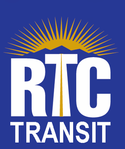RTC Transit
 |
|
| Parent | Regional Transportation Commission of Southern Nevada |
|---|---|
| Founded | December 5, 1992 (as Citizens Area Transit) |
| Headquarters | Las Vegas, Nevada |
| Locale | Clark County, Nevada |
| Service area | Southern Nevada: Las Vegas, North Las Vegas Henderson, Boulder City |
| Service type | Bus, Bus Rapid Transit, Paratransit |
| Routes | 51 |
| Stops | 3900+ |
| Stations | 4 |
| Fleet | 408 Fixed Route 300 Paratransit |
| Daily ridership | 178,390 (weekday) |
| Fuel type | Ultra Low-Sulfur Diesel, CNG. |
| Operator |
Keolis Transit America, MV Transportation, SNTC (fixed-route service), Transdev (ADA Paratransit) |
| Chief executive | Tina Quigley, General Manager |
| Website | rtcsnv.com |
RTC Transit is the name of the bus system in the Las Vegas metropolitan area of Clark County, Nevada. It is a subsidiary of the Regional Transportation Commission of Southern Nevada. While it services most of Clark County with regularly scheduled routes, most of the service is in the immediate Las Vegas Valley; outlying places such as Mesquite and Laughlin provide transit services to their residents by way of the Southern Nevada Transit Coalition, which uses several vehicles acquired from RTC Transit.
The privately owned Las Vegas Transit System, Inc. ("LVT") provided bus service on the streets of Las Vegas for more than 40 years. LVT service mainly consisted of loop routes that made many turns throughout the city, sometimes doubling back on its own routes and making several "subloops" within a loop. At one point, LVT was named America's worst transit system. Under pressure by the county and state, and by order of the state court, the company was ordered to cease operations and relinquish all its equipment, land, and property to the Regional Transportation Commission of Clark County.
Citizens Area Transit was formed by the RTC to provide reliable bus service to the cities of Las Vegas, North Las Vegas, Henderson, Las Vegas Township, Mesquite, and Laughlin. The system began on December 5, 1992 under the direction of Kurt Weinrich, its general manager. The fleet consisted of mostly old vehicles such as Flxible Grummans, GMC RTSs, TMC RTSs and Gillig Phantoms. They had also purchased 90 new New Flyer D40HFs. Soon after starting operations, CAT began to catch on with the city and blossomed. In 1997, the American Public Transportation Association awarded CAT with their highest honor, Best Transit System in America (within its category). However, things began to change in the following years. In 2002, The Amalgamated Transit Union and the bus contractor, ATC, began contract renewal negotiations, but the two sides were unable to reach a compromise on operators' wages and in May of that year, CAT suffered its first strike. Several drivers walked off the job and onto the picket lines, and service had to be suspended on several routes. Coach operators from sister agencies were called in to drive the buses and serve the city before a settlement was reached.
...
Wikipedia
